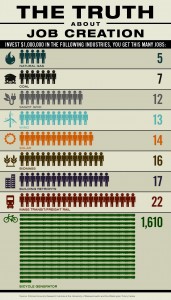How is Creating Green Jobs is Like Banning Tractors to Create Farm Jobs?
 Recently the “Political Economy Research Institute” at the University of Massachusetts released a graphic purporting to show “green” technologies create more jobs than traditional energy sources. The graphic, to the right, has been distributed widely by advocates of creating “green jobs.” This is a common assertion from the environmental left.
Recently the “Political Economy Research Institute” at the University of Massachusetts released a graphic purporting to show “green” technologies create more jobs than traditional energy sources. The graphic, to the right, has been distributed widely by advocates of creating “green jobs.” This is a common assertion from the environmental left.
As I note in my book Eco-Fads, this claim is made by many on the left.
One Seattle Times columnist wrote approvingly of a study that found spending on ‘green’ projects “produced more ‘job hours’ than tax cuts or traditional infrastructure spending.” This, they claim, is a good thing.
The left, however, is halfhearted in its application of this approach. If they really want to create more jobs we can do much better.
For example, the graph shows 14 jobs are created per $1 million invested in solar energy, twice the amount created from coal. But we can do better. We can generate 500,000 kilowatt hours (kWh) of perfectly clean energy (enough to power 80 houses for an entire year!) while creating hundreds of jobs.
I’ve modified the original graphic, which ended with the “Mass Transit/Freight Rail” row to include the best option of all – generating electricity using bicycle generators. Pedaling ten hours a day on a stationary bike, each person can generate 1 kWh. Investing $1 million in bicycle generators and paying people the going rate for the energy they create, we could create 1,610 jobs.
There is another benefit: these are not part time jobs. These are full-time jobs for an entire year, unlike many of the temporary jobs often included in “green” jobs calculations.
The reason solar power creates more jobs per $1 million is that solar is extremely inefficient, requiring more workers to do more as they produce less. We could easily apply this to other sectors.
If we want to create more farm jobs (after all the percentage of farm jobs in the economy has fallen dramatically in the last century), we could ban tractors. Think of all the jobs we’d create for farm workers!
Of course, the cost of farm products would rise dramatically, making it more difficult to buy food, especially for low-income families. But do we want to create jobs or not?!
If you’ve done the math by now, you may have figured out that I am paying my green-energy producing bike riders only 10 cents a day – the average rate for generating one kWh of electricity in America. So, let’s pay them $10 a hour. The cost per kWh would rise from 10 cents to $1,000. This might make it more difficult for manufacturers to buy the electricity, but it hardly seems fair to demand our bike riders earn less than a living wage, and wealthy investors like Warren Buffet can certainly afford to pay a bit more for electricity.
You may think that environmentalism and concern about resources means doing more with less. According to the Political Economy Research Institute and the environmental left, you would be wrong. They believe the way to create jobs and help the environment is by doing less with more – substituting high-cost solar power for low-cost natural gas. Using more resources (human and otherwise) and returning less energy.
And there are real-world examples of the “success” of this strategy. In 2008, Spain was widely lauded for its efforts to create a new, green economy. Today their unemployment rate is 25 percent.
The Pew Research Center ranks Oregon as the top state for “green jobs” in the country. Their unemployment rate has been above the national average every month for the last four years. Number three on the list is California, with a current unemployment rate of 10.9 percent. Last on the list? Natural gas rich North Dakota, with a current unemployment rate of 3 percent.
And I recently read that the wind energy projects in Spain were subsidized with tax payer money and that these subsidies have just been stopped because Spain (tax payers) can no longer afford the higher cost of wind generated electricity. Sound familiar?
Add the fact that the past decade’s huge emphasis on operating wind farms in Spain (built there by the likes of Spain’s own Iberdrola, Acciona, etc.), resulted in:
** 2.2 jobs lost for every job the wind industry claimed it created in Spain.
** Soaring unemployment now at 24.4% in Spain.
** Wind power electricity rates unaffordable to small businesses and to the citizenry, depleting their cash.
** Banks throughout Spain that are now on the verge of collapse because they gambled away enormous loans on economically infeasible and extraordinarily expensive wind farms.
The folks who promote subsidies know exactly what they are doing and it isn’t job creation, it is wealth redistribution.
This is a very interesting analysis. Often people get so caught up in the precise number of jobs being created that they do not realize the long-term ramifications of these “green” jobs. Sometimes you have to employ less people to ultimately save more money for more people – as this analysis aptly describes.
I’ve used the bicycle analogy for years now to show the absurdity of using more manpower to create less and more expensive electricity. It’s great to see someone else pick up on it.